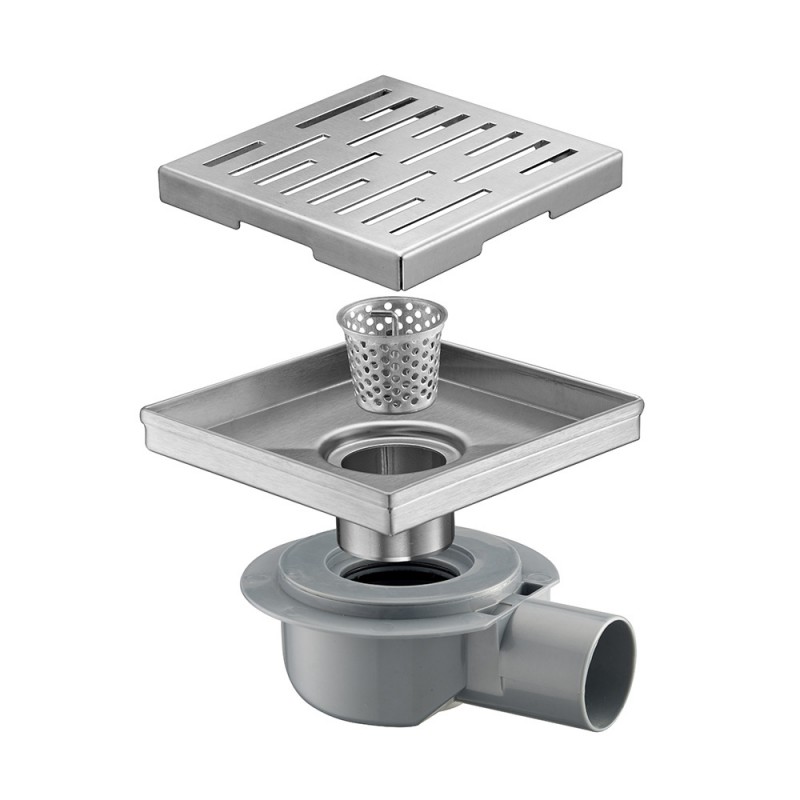How To Naturally Unclog A Shower Drain?
A clogged Shower Drain is a common issue in both residential and commercial bathrooms, caused by a buildup of soap scum, hair, oil, and other debris. While chemical drain cleaners offer a quick fix, they often damage pipes and harm the environment. Fortunately, there are natural and effective ways to unclog a shower drain using safe, household ingredients and smart maintenance practices.
This article explains why shower drains get clogged, provides natural cleaning solutions, offers step-by-step methods to clear blockages, and outlines important precautions to maintain a clean, free-flowing drain—all aligned with environmentally friendly practices.
1. Why Shower Drains Get Clogged
Understanding what causes a shower drain blockage is the first step toward solving the problem naturally. Most clogs form gradually over time, resulting from a combination of organic matter and mineral buildup.
Common Causes of Shower Drain Clogs
Hair Accumulation
Hair is the most common culprit. Strands combine with soap residue and stick to the inside of pipes, creating dense tangles that block water flow.Soap Scum and Body Oils
Soap residue reacts with hard water minerals like calcium and magnesium, forming a sticky layer that narrows the pipe’s diameter.Shampoo and Conditioner Residue
Many personal care products contain silicone, wax, or oil-based compounds that solidify inside pipes over time.Dead Skin Cells and Dirt
Microscopic debris from daily washing accumulates, contributing to the formation of sludge in the drain line.Hard Water Deposits
Mineral scale builds up along pipe walls, reducing water flow and trapping other materials more easily.Foreign Objects
Small items like razor caps, jewelry, or pieces of plastic can accidentally fall into the drain, causing sudden blockages.
These problems worsen in drains without proper strainers or regular cleaning routines. The good news is that most clogs can be resolved naturally without harsh chemicals or professional intervention.
2. The Benefits of Natural Cleaning Methods
Many homeowners instinctively reach for chemical drain cleaners, but these contain corrosive substances such as sodium hydroxide (lye) or sulfuric acid, which can damage metal or PVC pipes and release harmful fumes.
Advantages of Natural Solutions
Safe for Pipes: Gentle ingredients like baking soda and vinegar won’t corrode plumbing components.
Eco-Friendly: Reduces chemical pollution in wastewater systems.
Budget-Friendly: Uses everyday household items, minimizing maintenance costs.
Odor Control: Natural agents eliminate foul smells without synthetic fragrances.
Prevention: Regular use can help maintain a smooth, odor-free drainage system.
Natural unclogging not only solves the immediate issue but also protects your home’s plumbing for the long term.
3. Step-by-Step Natural Methods to Unclog a Shower Drain
Below are several proven methods using common household items to remove clogs safely. Depending on the severity of the blockage, one or a combination of these methods can restore proper drainage.
Method 1: The Baking Soda and Vinegar Reaction
This is one of the most effective and natural drain-cleaning techniques, relying on a simple chemical reaction.
You’ll Need:
1 cup of baking soda
1 cup of white vinegar
Boiling water
Steps:
Pour a full cup of baking soda directly into the drain.
Follow with one cup of white vinegar.
Let the mixture fizz for 15–20 minutes; this reaction breaks down soap and grease buildup.
Flush the drain with a kettle of boiling water to wash away loosened debris.
Why It Works:
The fizzing process releases carbon dioxide, which agitates and softens the blockage, while the boiling water pushes it through the pipe.
Method 2: Salt and Baking Soda Mix
If vinegar isn’t available, salt can act as an abrasive cleaner to loosen material.
You’ll Need:
½ cup of salt
½ cup of baking soda
Boiling water
Steps:
Mix the salt and baking soda together and pour into the drain.
Let it sit overnight (at least 6–8 hours).
Pour boiling water slowly to flush out residue the next morning.
Why It Works:
The coarse texture of salt scrubs the inside of the pipe, while baking soda neutralizes acidic buildup and odors.
Method 3: Boiling Water Flush
For minor blockages caused by soap scum, hot water alone can sometimes restore drainage.
Steps:
Boil about 1–2 liters of water.
Slowly pour the water into the drain in stages, allowing each pour to work for 10–15 seconds.
Repeat this two or three times.
Why It Works:
Heat melts fatty deposits and soap residue, clearing the pathway without additional agents. This method is safe for metal pipes but should be used cautiously with PVC plumbing (use hot, not boiling, water for plastic pipes).
Method 4: Manual Removal with a Drain Snake or Hook
When clogs are caused by hair, a simple manual approach works best.
Tools Needed:
A drain snake (flexible cleaning tool) or a straightened wire hanger
Gloves and flashlight
Steps:
Remove the drain cover or grate carefully.
Insert the snake or wire hook into the pipe.
Twist gently while pulling upward to collect hair and debris.
Rinse the drain with warm water afterward.
Why It Works:
Physical removal eliminates the most stubborn blockages that chemical solutions cannot dissolve. It’s particularly effective in bathrooms with long hair accumulation.
Method 5: Use of Enzyme Cleaners (Optional Natural Alternative)
If you prefer a ready-made solution, bio-enzymatic drain cleaners are eco-safe products that contain bacteria and enzymes to digest organic waste.
Benefits:
Non-toxic and biodegradable
Safe for all types of plumbing
Long-term maintenance-friendly
Enzyme cleaners are ideal for routine upkeep once the main blockage has been cleared.
4. Preventive Maintenance for a Clean Shower Drain
Preventing future blockages is just as important as removing the current one. Simple habits can extend the life of your drain system and minimize the need for cleaning.
Install a Drain Strainer
Place a stainless-steel or silicone strainer over the drain opening to catch hair and debris. Clean it every few days.
Rinse with Hot Water Weekly
Pouring a small amount of hot water down the drain once a week helps dissolve soap residue before it hardens.
Use Baking Soda Regularly
Sprinkle a few tablespoons of baking soda into the drain weekly, followed by hot water. It keeps the interior clean and prevents odors.
Avoid Pouring Oils or Lotions Down the Drain
These substances solidify over time and are difficult to remove without professional help.
Check the P-Trap
If water drains slowly even after cleaning, the U-shaped P-trap under the floor might contain buildup. This can be removed manually or flushed periodically by a plumber.
Regular maintenance keeps the water flowing freely and reduces the chances of unpleasant smells or expensive repairs.
5. Important Precautions When Unclogging Drains Naturally
While natural cleaning is safer than chemical methods, following proper safety steps is still essential.
Do Not Mix Different Cleaners
Avoid combining vinegar with commercial chemical cleaners, as this can produce toxic gases.
Protect Your Hands and Eyes
Wear rubber gloves and safety glasses if you’re handling hot water or using drain tools.
Test Water Temperature
If using boiling water on PVC pipes, let the water cool slightly to prevent warping or cracking.
Avoid Metal Scratches
When removing drain covers or using tools, take care not to damage stainless-steel or chrome finishes.
Ensure Good Ventilation
Even natural reactions can release mild vapors, so keep windows open during cleaning.
Repeat Rather Than Overdo
If the drain remains partially blocked, repeat the natural process after 24 hours instead of using large quantities at once.
By following these precautions, you protect both your plumbing system and your own safety while keeping your bathroom eco-friendly.
6. When to Seek Professional Help
Although natural methods work in most cases, some clogs may be too deep or severe for DIY solutions. You should consider calling a professional plumber when:
The drain backs up repeatedly after cleaning.
You notice slow drainage in multiple fixtures (sink, shower, toilet), suggesting a main line issue.
Water starts to leak around the shower floor or subfloor.
There’s a persistent foul odor even after cleaning the trap.
A professional inspection can identify structural issues such as pipe corrosion, misalignment, or deep-rooted obstructions.
Conclusion
Learning how to naturally unclog a shower drain helps you maintain a clean, efficient, and environmentally safe bathroom. By using simple ingredients like baking soda, vinegar, salt, and hot water, you can solve most drainage issues without resorting to toxic chemicals. Regular upkeep—such as cleaning strainers, running hot water, and applying preventive treatments—ensures long-term performance and hygiene.
A free-flowing shower drain not only improves comfort but also protects your plumbing system and the planet. With consistent care, you’ll enjoy clear drains, cleaner air, and peace of mind every time you step into your shower.
Previous: How To Make A Shower Drain?




